The Economics and Statistics Division maintains archives of previous publications for accountability purposes, but makes no updates to keep these documents current with the latest data revisions from Statistics Canada. As a result, information in older documents may not be accurate. Please exercise caution when referring to older documents. For the latest information and historical data, please contact the individual listed to the right.
<--- Return to Archive
For additional information relating to this article, please contact:
February 10, 2017HOURS WORKED AND LABOUR PRODUCTIVITY, 2015 [REVISED] Statistics Canada has released revised labour productivity accounts for the provinces for 1997-2015. These revisions are consistent with those incorporated in the provincial and territorial economic accounts and the provincial and territorial gross domestic product by industry, released on November 9, 2016.
For 2015, Nova Scotia's labour productivity in the business sector increased by 2.3 per cent following growth of 1.5 per cent in 2014 and 2013. Canada labour productivity in business sector was down 0.4 per cent in 2015. In Nova Scotia, 35.2 dollars (chained 2007) of GDP are produced per hour of work and in Canada 49.8 dollars per hour.
In 2015, Nova Scotia's real labour productivity in the business sector(chained $2007 dollars per hour worked) grew by 2.3 per cent as real output was up 1.0 per cent and hours worked were down 1.3 per cent. The goods-producing sector productivity rose 0.2 per cent, while productivity in the service sector was up 3.1 per cent. Productivity in Canada was down 0.3 per cent in the goods sector and up 0.2 for the service sector.
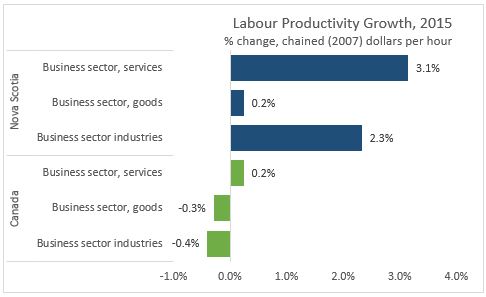
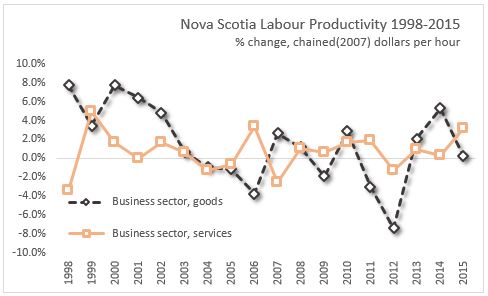
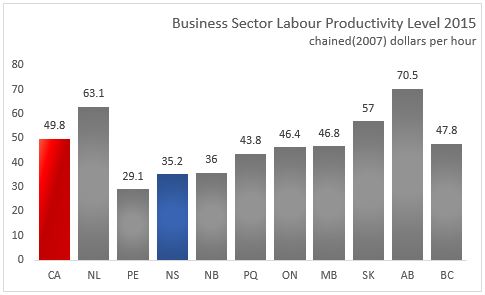
Business sector productivity fell in Newfoundland and Labrador, Saskatchewan and Alberta in 2015 with output declining faster than the decline in hours in all three provinces. Quebec labour productivity was down 0.7 per cent with a gain in real output of 1.7 per cent outpaced by a 2.4 per cent rise in hours worked. Prince Edward Island saw the largest increase in productivity as output growth of 1.7 per cent was accompanied by a decline in hours worked of 3.6 per cent.
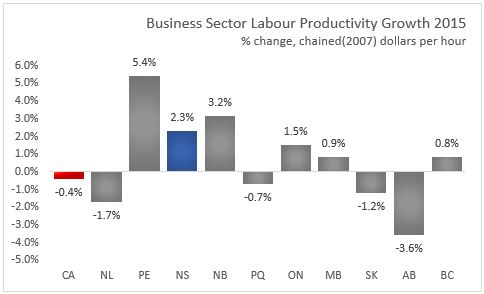

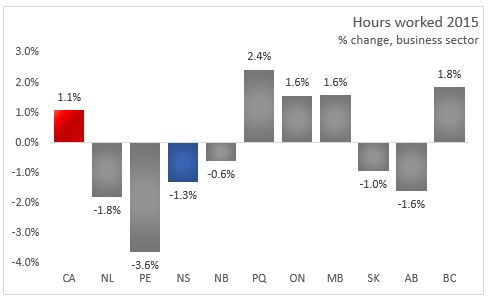
Compensation per hour of work in the business sector was up 3.7 per cent in Nova Scotia to $24.92. Total compensation for business sector industries was up 2.4 per cent and hours worked was down 1.3 per cent. Nova Scotia had the third lowest level among the provinces after Prince Edward Island and New Brunswick. Compensation per hour worked was up in all the provinces, except Alberta, rising 1.9 per cent for Canada and led by increases in Newfoundland and Labrador (+5.2 per cent) and Prince Edward Island (+7.7 per cent).
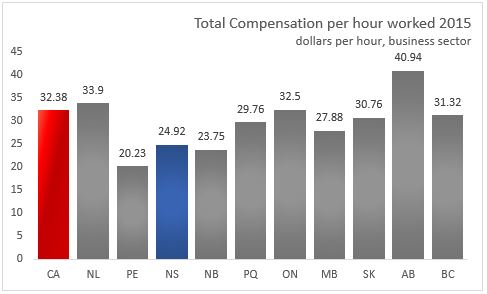

With compensation per hour worked (+3.7 per cent) rising faster than labour productivity (+2.3 per cent), the unit labour cost (dollars per unit of real GDP) was up in Nova Scotia by 1.4 per cent in 2015. Unit labour costs were up for all provinces and increased 2.4 per cent for Canada. Unit labour costs in US dollars were down for all provinces with the depreciation in the exchange rate.


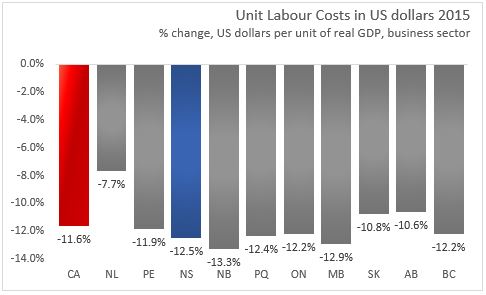
Within Nova Scotia, labour productivity of goods sector was up slightly as increases in resource industries and manufacturing were offset by declines in utilities and construction. Manufacturing productivity was up 2.8 per cent with real output increasing 3.7 per cent and hours worked rising 1.0 per cent. Non-durable manufacturing labour productivity was down 3.9 per cent with hours rising and output falling while durable manufacturing labour productivity was up 12.3 per cent as output rose 8.9 per cent hours worked fell. Mining, and oil and gas extraction was up 3.8 per cent and hours worked (-23.7 per cent) declined more than output (-20.8 per cent).
Labour productivity was up in all but two service subsectors as output was up 1.3 per cent in the sector and hours worked fell 1.8 per cent.

For more information, see Statistics Canada CANSIM series numbers 383-0031 to 383-0033
<--- Return to Archive